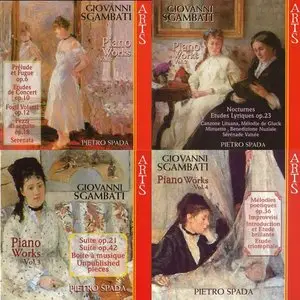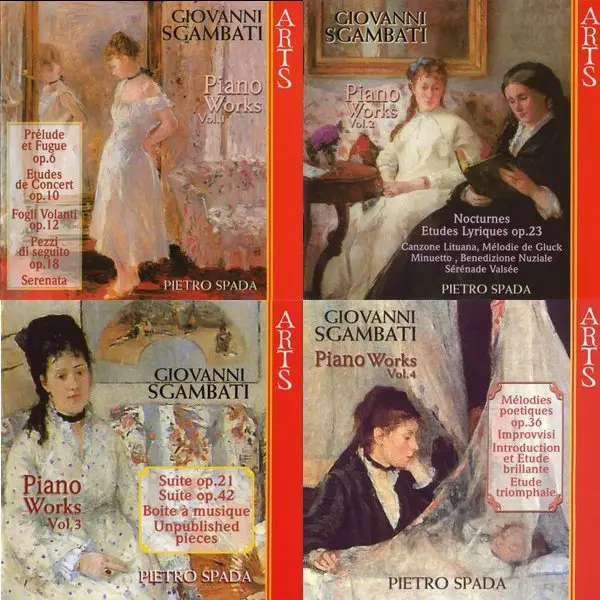Giovanni Sgambati - Piano Works (Pietro Spada)
Arts Red Line | 1998 | 4 CD | 4 RAR | 449Mb
MP3 192 Kbps | Lame encoded | Tracks, Covers | Fserve, Fsonic
Arts Red Line | 1998 | 4 CD | 4 RAR | 449Mb
MP3 192 Kbps | Lame encoded | Tracks, Covers | Fserve, Fsonic
The German company Arts Music enterprisingly took up the offer of pianist and Sgambati authority, Pietro Spada, to record the Italian composer’s complete works for solo piano.
Giovanni Sgambati was born in Rome and he died there. Bald facts tell only part of the story. He was in fact no parochialist and briefly his music permeated European and American cultural life with celebrity premieres by no means unusual in the period 1880-1905. He was out of the ordinary as an Italian composer in not writing opera. To this extent he laboured under the same burden as Martucci. Liszt took the young composer under his wing and introduced him to Wagner. It was Wagner’s intervention with Schotts that resulted in that company publishing many of Sgambati’s chamber works. He was also active as a conductor championing the German repertoire. He conducted Liszt’s Dante Symphony in 1866. Fellow Italian composer Alfredo Casella wrote an article about Sgambati (Music and Letters, 1925).
The first disc: The Prelude is splendidly nagging and there is then a pensively relaxed Fugue. The Etudes de Concert are taut and romantic - the second of these is rather stiff. The Schumann-like Fogli Volante are a poetic sequence - broadly centred in Schumann-Macdowell territory. The highlight is the Campane festa which is outstandingly atmospheric, beautifully weighted and flighted by Spada. Of the Quattro Pezzi Op. 18, the Minuetto and the Toccata are mechanically patterned and rigid. The Preludio and Nenia are, by contrast, strongly atmospheric romantic pieces. The Serenata (extracted from the First Symphony) is a song swung with muscular romantic reach - leonine and Brahmsian. What Rudolf Serkin would have made of this at his peak!
CD2: The Six Nocturnes Opp. 20, 31, 33 are well worth hearing. Their ‘tribute’ is paid more to Chopin than to Field; more to Grieg than to Liszt. I commend these Nocturnes to any young player wanting to surprise her or his audience or a competition jury with something other than Chopin. The Lyrical Pieces Op. 23 are quite varied with a liquid and almost impressionistic À la fontaine contrasting with a dramatic Wagnerian night scene in Vox Populi. The Beethoven Minuet is a faithful mood parallel.
CD3: The Op. 21 Suite in five movements is the stuff of charm rather than anything else and triangulates pleasingly between Chopin, Brahms and Grieg. The Boite à Musique is a most skilful emulation of the clockwork music-box effect - extremely attractive. The Romance and the Gavotte are grandly Brahmsian. The Melodia Campestre from his very late Op. 42 suite uses a serenade-like tune in the Neapolitan manner. The plums among the unpublished pieces include the Presentimento and the lapping and rocking motion of the Preludio.
The fourth and final volume of the series is the shortest playing of the four. It includes the Mélodies Poétiques Op. 36. The sea-swell of Rivelazione is well put across by Spada. Who could resist the simplicity and singing charm of En valsant. The Profonda pena is more poignant, more searching. Spada rescued the Five Improvvisi from unpublished obscurity. The cradle-rocking No. 3 with the Gavotte-like No. 4 are the pick of the bunch.
Sgambati was by no means a mere miniaturist. His First Symphony was written in 1881. The Second followed two years later. The Piano Concerto was written in 1871. Two piano quintets date from the period 1866-70 and both are recorded on ASV-Sanctuary. In addition there is a Requiem for baritone, chorus and orchestra in 1895. The Requiem dates from 1895 and was written to mark the death of King Victor Emmanuel II then revised on the murder of King Umberto I in 1901. The First Symphony was dedicated to the Royal Family being premiered under Toscanini’s baton at the Quirinale. His works were given in all the major European cultural centres. The Requiem, First Symphony and Piano Concerto were all performed in London. In the Requiem a Fauré-like reticence meets the drama of apocalyptic visions. The Piano Concerto has been recorded several times and Carus have a good version of the Requiem. As for the Symphonies, the First has been recorded by Actes-Sud coupled with the Piano Concerto (Alexander Paley, piano; Montpellier National Orchestra/Friedemann Layer) while the Second Symphony and the substantial suite Epitalamo Sinfonico (occasionally referred to as the Third Symphony) remain up for grabs.
Pietro Spada provides the in-depth notes based on many years researching Sgambati. You will come away from reading these with your knowledge of Sgambati and his milieu deepened and widened.
This series sheds pleasing and definitive light on a neglected corner of the romantic repertoire. You can buy these discs separately so if you intend to buy only one then go for Vol. 1 with the remarkable Fogli Volanti. This music will be sure to ingratiate if you lap up Brahms, Grieg and Schumann. Sgambati had a fine mind and his pieces are often superbly structured for clarity and romantic sensibility. Spada very occasionally articulates the music stiffly. In general though, encouraged by the excellence of many of these pieces, he rises to the challenge with high honours.
Rob Barnett
contents:
CD 1
1-2 Prelude and Fugue for Piano, Op. 6
3 Concert Etude for Piano in D flat major, Op. 10 no 1
4 Concert Etude for Piano in F sharp minor, Op. 10 no 2
5-13 Fogli volanti, Op. 12
14-17 Pezzi di seguito (4), Op. 18
18 Serenata napoletana, Op. 24 no 2
CD 2
1-6 6 Notturni
7 Pieces Lyriques op. 23 - Rapelle-toi (Romance), in E major
8 Pieces Lyriques op. 23 - A la fontaine, in D flat major
9 Pieces Lyriques op. 23 - Vox populi, in F major
10 Pieces Lyriques op. 23 - Do-Do, in F major
11 Pieces Lyriques op. 23 - Landler, in E major
12 Pieces Lyriques op. 23 - Gigue, in E major
13 Benedizione Nuziale, in A flat major
14 Canzone Lituana in F major
15 Melodie de Gluck in D minor
16 Minuetto von Beethoven in G flat major
17 Serenade Valsee, in A flat major
CD 3
1 Suite In B Minor Op. 21: Prelude, In B Minor
2 Suite In B Minor Op. 21: Valse, In B Minor
3 Suite In B Minor Op. 21: Air, In B Minor
4 Suite In B Minor Op. 21: Intermezzo, In E Major
5 Suite In B Minor Op. 21: Etude Melodique, In B Major
6 Boite A Musique, In D Flat Major
7 Romanza, In A Major
8 Gavotta, In A Flat Minor
9 Suite Op. 42: Preludio
10 Suite Op. 42: Berceuse Reverie
11 Suite Op. 42: Melodia Campestre
12 Unpublished Pieces: Serenatina
13 Unpublished Pieces: Scherzo, In E Major
14 Unpublished Pieces: Presentimento, In A Flat Major
15 Unpublished Pieces: Mestizia, In F Sharp Minor
16 Unpublished Pieces: Romanza, In F Major
17 Unpublished Pieces: Preludio, In C Major
CD 4
1-13 Melodies poetiques for Piano, Op. 36
14-18 Improvisations (5) for Piano
19 Introduction and Etude Brillante for Piano
20 Etude Triomfale
CD 1
1-2 Prelude and Fugue for Piano, Op. 6
3 Concert Etude for Piano in D flat major, Op. 10 no 1
4 Concert Etude for Piano in F sharp minor, Op. 10 no 2
5-13 Fogli volanti, Op. 12
14-17 Pezzi di seguito (4), Op. 18
18 Serenata napoletana, Op. 24 no 2
CD 2
1-6 6 Notturni
7 Pieces Lyriques op. 23 - Rapelle-toi (Romance), in E major
8 Pieces Lyriques op. 23 - A la fontaine, in D flat major
9 Pieces Lyriques op. 23 - Vox populi, in F major
10 Pieces Lyriques op. 23 - Do-Do, in F major
11 Pieces Lyriques op. 23 - Landler, in E major
12 Pieces Lyriques op. 23 - Gigue, in E major
13 Benedizione Nuziale, in A flat major
14 Canzone Lituana in F major
15 Melodie de Gluck in D minor
16 Minuetto von Beethoven in G flat major
17 Serenade Valsee, in A flat major
CD 3
1 Suite In B Minor Op. 21: Prelude, In B Minor
2 Suite In B Minor Op. 21: Valse, In B Minor
3 Suite In B Minor Op. 21: Air, In B Minor
4 Suite In B Minor Op. 21: Intermezzo, In E Major
5 Suite In B Minor Op. 21: Etude Melodique, In B Major
6 Boite A Musique, In D Flat Major
7 Romanza, In A Major
8 Gavotta, In A Flat Minor
9 Suite Op. 42: Preludio
10 Suite Op. 42: Berceuse Reverie
11 Suite Op. 42: Melodia Campestre
12 Unpublished Pieces: Serenatina
13 Unpublished Pieces: Scherzo, In E Major
14 Unpublished Pieces: Presentimento, In A Flat Major
15 Unpublished Pieces: Mestizia, In F Sharp Minor
16 Unpublished Pieces: Romanza, In F Major
17 Unpublished Pieces: Preludio, In C Major
CD 4
1-13 Melodies poetiques for Piano, Op. 36
14-18 Improvisations (5) for Piano
19 Introduction and Etude Brillante for Piano
20 Etude Triomfale



